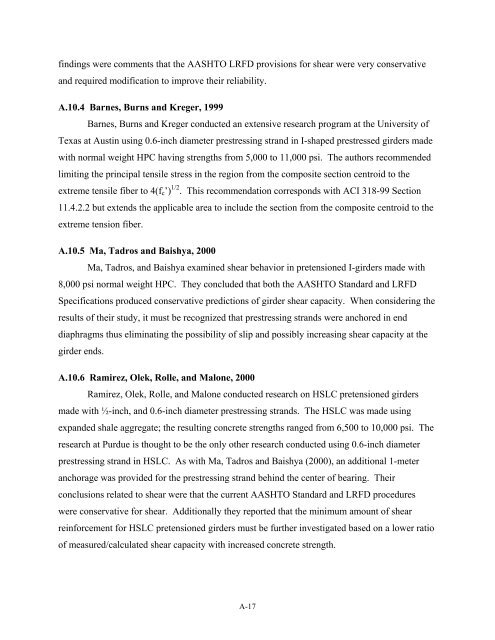Lightweight Concrete for High Strength - Expanded Shale & Clay
Lightweight Concrete for High Strength - Expanded Shale & Clay
Lightweight Concrete for High Strength - Expanded Shale & Clay
Create successful ePaper yourself
Turn your PDF publications into a flip-book with our unique Google optimized e-Paper software.
findings were comments that the AASHTO LRFD provisions <strong>for</strong> shear were very conservative<br />
and required modification to improve their reliability.<br />
A.10.4 Barnes, Burns and Kreger, 1999<br />
Barnes, Burns and Kreger conducted an extensive research program at the University of<br />
Texas at Austin using 0.6-inch diameter prestressing strand in I-shaped prestressed girders made<br />
with normal weight HPC having strengths from 5,000 to 11,000 psi. The authors recommended<br />
limiting the principal tensile stress in the region from the composite section centroid to the<br />
extreme tensile fiber to 4(f c ’) 1/2 . This recommendation corresponds with ACI 318-99 Section<br />
11.4.2.2 but extends the applicable area to include the section from the composite centroid to the<br />
extreme tension fiber.<br />
A.10.5 Ma, Tadros and Baishya, 2000<br />
Ma, Tadros, and Baishya examined shear behavior in pretensioned I-girders made with<br />
8,000 psi normal weight HPC. They concluded that both the AASHTO Standard and LRFD<br />
Specifications produced conservative predictions of girder shear capacity. When considering the<br />
results of their study, it must be recognized that prestressing strands were anchored in end<br />
diaphragms thus eliminating the possibility of slip and possibly increasing shear capacity at the<br />
girder ends.<br />
A.10.6 Ramirez, Olek, Rolle, and Malone, 2000<br />
Ramirez, Olek, Rolle, and Malone conducted research on HSLC pretensioned girders<br />
made with ½-inch, and 0.6-inch diameter prestressing strands. The HSLC was made using<br />
expanded shale aggregate; the resulting concrete strengths ranged from 6,500 to 10,000 psi. The<br />
research at Purdue is thought to be the only other research conducted using 0.6-inch diameter<br />
prestressing strand in HSLC. As with Ma, Tadros and Baishya (2000), an additional 1-meter<br />
anchorage was provided <strong>for</strong> the prestressing strand behind the center of bearing. Their<br />
conclusions related to shear were that the current AASHTO Standard and LRFD procedures<br />
were conservative <strong>for</strong> shear. Additionally they reported that the minimum amount of shear<br />
rein<strong>for</strong>cement <strong>for</strong> HSLC pretensioned girders must be further investigated based on a lower ratio<br />
of measured/calculated shear capacity with increased concrete strength.<br />
A-17















